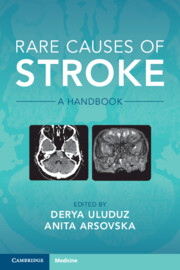Book contents
- Rare Causes of Stroke
- Rare Causes of Stroke
- Copyright page
- Contents
- Contributors
- Preface
- 1 Inflammatory Conditions
- 2 Infectious and Postinfectious Vasculitis
- 3 Hypercoagulable Causes of Stroke
- 4 Drug-Related Stroke
- 5 Hereditary and Genetic Causes of Stroke
- 6 Rare Causes of Cardioembolism
- 7 Vasospastic Conditions and Other Vasculopathies
- Chapter 7.1 Reversible Cerebral Vasoconstriction Syndrome
- Chapter 7.2 Eclampsia and Strokes during Pregnancy and Postpartum
- Chapter 7.3 Migraines and Migraine-Like Conditions
- 8 Other Non-inflammatory Vasculopathies
- 9 Venous Occlusive Conditions
- 10 Bone Disorders and Stroke
- Index
- References
Chapter 7.2 - Eclampsia and Strokes during Pregnancy and Postpartum
from 7 - Vasospastic Conditions and Other Vasculopathies
Published online by Cambridge University Press: 06 October 2022
- Rare Causes of Stroke
- Rare Causes of Stroke
- Copyright page
- Contents
- Contributors
- Preface
- 1 Inflammatory Conditions
- 2 Infectious and Postinfectious Vasculitis
- 3 Hypercoagulable Causes of Stroke
- 4 Drug-Related Stroke
- 5 Hereditary and Genetic Causes of Stroke
- 6 Rare Causes of Cardioembolism
- 7 Vasospastic Conditions and Other Vasculopathies
- Chapter 7.1 Reversible Cerebral Vasoconstriction Syndrome
- Chapter 7.2 Eclampsia and Strokes during Pregnancy and Postpartum
- Chapter 7.3 Migraines and Migraine-Like Conditions
- 8 Other Non-inflammatory Vasculopathies
- 9 Venous Occlusive Conditions
- 10 Bone Disorders and Stroke
- Index
- References
Summary
Typical neuroimaging presentation of preeclampsia/eclampsia are posterior reversible encephalopathy syndrome (PRES) and reversible cerebral vasoconstriction syndrome (RCVS).Eclampsia carries a high risk for stroke, both hemorrhagic and ischemic. Besides eclampsia, pregnancy-specific causes of ischemic stroke are peripartum cardiomyopathy, postpartum benign angiopathy, amniotic fluid embolization and choriocarcinoma.The incidence of cerebral venous thrombosisis the highest during postpartum and is increased in older women, cesarean delivery, or epidural anesthesia, in the presence of infection, obesity or thrombophilia. Risk factors for hemorrhagic stroke during pregnancy and postpartum are older age, pregestational and gestational hypertension, preeclampsia/eclampsia, coagulopathies, and smoking
- Type
- Chapter
- Information
- Rare Causes of StrokeA Handbook, pp. 299 - 304Publisher: Cambridge University PressPrint publication year: 2022

